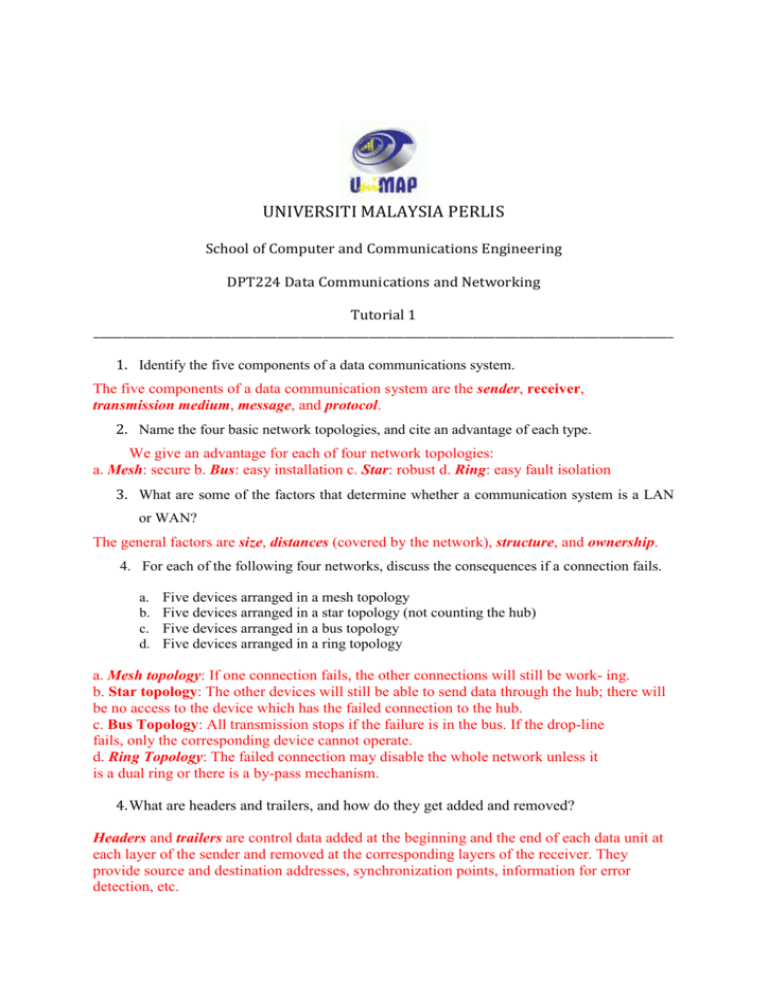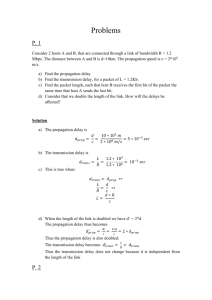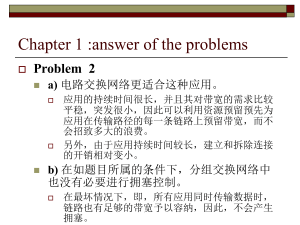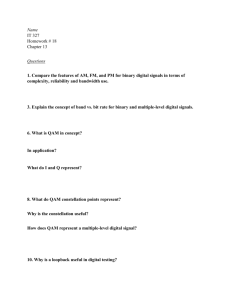Tutorial 1 Answers
advertisement

UNIVERSITI MALAYSIA PERLIS School of Computer and Communications Engineering DPT224 Data Communications and Networking Tutorial 1 _____________________________________________________________________________________________________ 1. Identify the five components of a data communications system. The five components of a data communication system are the sender, receiver, transmission medium, message, and protocol. 2. Name the four basic network topologies, and cite an advantage of each type. We give an advantage for each of four network topologies: a. Mesh: secure b. Bus: easy installation c. Star: robust d. Ring: easy fault isolation 3. What are some of the factors that determine whether a communication system is a LAN or WAN? The general factors are size, distances (covered by the network), structure, and ownership. 4. For each of the following four networks, discuss the consequences if a connection fails. a. b. c. d. Five devices arranged in a mesh topology Five devices arranged in a star topology (not counting the hub) Five devices arranged in a bus topology Five devices arranged in a ring topology a. Mesh topology: If one connection fails, the other connections will still be work- ing. b. Star topology: The other devices will still be able to send data through the hub; there will be no access to the device which has the failed connection to the hub. c. Bus Topology: All transmission stops if the failure is in the bus. If the drop-line fails, only the corresponding device cannot operate. d. Ring Topology: The failed connection may disable the whole network unless it is a dual ring or there is a by-pass mechanism. 4. What are headers and trailers, and how do they get added and removed? Headers and trailers are control data added at the beginning and the end of each data unit at each layer of the sender and removed at the corresponding layers of the receiver. They provide source and destination addresses, synchronization points, information for error detection, etc. 6. What is the difference between a port address, a logical address, and a physical address? The physical address is the local address of a node; it is used by the data link layer to deliver data from one node to another within the same network. The logical address defines the ol-02.fm Page 3 Saturday, January 21, 2006 10:27 AM sender and receiver at the network layer and is used to deliver messages across multiple networks. The port address (service-point) identifies the application process on the station. 7. In Figure below, computer A sends a message to computer D via LANl,3 router Rl, and LAN2. Show the contents of the packets and frames at the network and data link layer for d. each hop interface. Responsibility for carrying frames between adjacent nodes: data link layer Page 3 Saturday, January 21, 2006 10:27 AM 3 19. a. Format and code conversion services: presentation layer d. Responsibility for carrying frames adjacent nodes: data link b. Establishing, managing, andbetween terminating sessions: session layerlayer 19. c. Ensuring reliable transmission of data: data link and transport layers a. Format and code services: presentation d. Log-in andconversion log-out procedures: session layerlayer b. Establishing, managing, and terminating sessions: layer presentation layer e. Providing independence from different datasession representation: c. 20. Ensuring reliable transmission of data: data link and transport layers See Figure 2.1. d. Log-in and log-out procedures: session layer e. Figure Providing from different data representation: presentation layer 2.1 independence Solution to Exercise 20 20. See Figure 2.1. Figure 2.1 Solution to Exercise A/40 20 LAN1 LAN2 R1 A/40 Sender LAN1 B/42 D/80 C/82 LAN2 R1 Sender Sender 42 40B/42 A D Data T2C/82 80 82 AD/80 D Data T2 Sender 21. See Figure 2.2. 80 82 A D Data T2 is between a process running at 42 40 A D Data 8. In Figure 2.22, assume thatT2the communication computer with port address Figure 2.2A Solution to Exercise 21 i and a process running at computer D with port address j. 21. See Figure Show the2.2. contents of packets and frames at the network, data link, and transport layer for each hop. LAN1 LAN2 Figure 2.2 Solution to Exercise 21 A/40 R1 A/40 Sender LAN1 B/42 C/82 LAN2 R1 Sender 42 40 A D i B/42 j Data D/80 Sender D/80 T2 C/8280 82 A D i j Data T2 Sender 22. If the corrupted destination address does not match any station address in the net42 40 80 82 A destination A D is i lost. j Data D i j Dataaddress T2 work, the packet If theT2corrupted matches one of the stations, the frame is delivered to the wrong station. In this case, however, the error detection destination mechanism,address available in not most data link protocols, will find error and 22. If the corrupted does match any station address in thethenetdiscard the frame. In both cases, the source will somehow be informed using packet lost. If theeach corrupted destination address matches one of the sta- one 9. work, Whatthe isthe thedata bitislink rate for of the following signals? of control mechanisms discussed in Chapter 11. tions, frame is in delivered to1 the wrong station.s In this case, however, the error a.23. the A signal which bit lasts 0.001 Before using the destination address in an intermediate or the destination node, the detection mechanism, available in most data link protocols, will find the error and b. packet A signal inthrough whicherror 1 bitchecking lasts 2 ms goes that may help the node find the corruption discard the frame. In both cases, the source will somehow be informed using one A signal inprobability) which 10and bits last 20 (with a high discard theinJ-ls packet. Normally the upper layer protocol ofc.the data link control mechanisms discussed Chapter 11. will inform the source to resend the packet. 23. Before using the destination address in an intermediate or the destination node, the packet goes through error checking that may help the node find the corruption (with a high probability) and discard the packet. Normally the upper layer protocol will inform the source to resend the packet. a. bitrate=1/(bitduration)=1/(0.001s)=1000bps=1Kbps b. bitrate=1/(bitduration)=1/(2ms)=500bps c. bitrate=1/(bitduration)=1/(20μs/10)=1/(2μs)=500Kbps 10. A signal travels from point A to point B. At point A, the signal power is 100 W. At point B, the power is 90 W. What is the attenuation in decibels? dB=10log10 (90/100)=–0.46dB 11. If the bandwidth of the channel is 5 Kbps, how long does it take to send a frame of 100,000 bits out of this device? 100,000 bits / 5 Kbps = 20 s 12. A line has a signal-to-noise ratio of 1000 and a bandwidth of 4000 KHz. What is the maximum data rate supported by this line? 4,000 log2 (1 + 1,000) ≈ 40 Kbps 13. Define FHSS and explain how it achieves bandwidth spreading. The frequency hopping spread spectrum (FHSS) technique uses M different carrier frequencies that are modulated by the source signal. At one moment, the signal modulates one carrier frequency; at the next moment, the signal modulates another carrier frequency. 14. Define DSSS and explain how it achieves bandwidth spreading. The direct sequence spread spectrum (DSSS) technique expands the bandwidth of the original signal. It replaces each data bit with n bits using a spreading code. 15. Assume that a voice channel occupies a bandwidth of 4 kHz. We need to multiplex 10 voice channels with guard bands of 500 Hz using FDM. Calculate the required bandwidth. To multiplex 10 voice channels, we need nine guard bands. The required band- width is then B = (4 KHz) × 10 + (500 Hz) × 9 = 44.5 KHz 16. We need to use synchronous TDM and combine 20 digital sources, each of 100 Kbps. Each output slot carries 1 bit from each digital source, but one extra bit is added to each frame for synchronization. Answer the following questions: a. What is the size of an output frame in bits? b. What is the output frame rate? c. What is the duration of an output frame? d. What is the output data rate? e. What is the efficiency of the system (ratio of useful bits to the total bits). a. Each output frame carries 1 bit from each source plus one extra bit for synchro- nization. Frame size = 20 × 1 + 1 = 21 bits. b. Each frame carries 1 bit from each source. Frame rate = 100,000 frames/s. c. Frame duration = 1 /(frame rate) = 1 /100,000 = 10 μs. d. Data rate = (100,000 frames/s) × (21 bits/frame) = 2.1 Mbps e. In each frame 20 bits out of 21 are useful. Efficiency = 20/21= 95% 17. Ten sources, six with a bit rate of 200 kbps and four with a bit rate of 400 kbps are to be combined using multilevel TDM with no synchronizing bits. Answer the fol- lowing questions about the final stage of the multiplexing: a. What is the size of a frame in bits? b. What is the frame rate? c. What is the duration of a frame? d. What is the data rate? We combine six 200-kbps sources into three 400-kbps. Now we have seven 400- kbps channel. a. Each output frame carries 1 bit from each of the seven 400-kbps line. Frame size = 7 × 1 = 7 bits. b. Each frame carries 1 bit from each 400-kbps source. Frame rate = 400,000 frames/s. c. Frame duration = 1 /(frame rate) = 1 /400,000 = 2.5 μs. d. Output data rate = (400,000 frames/s) × (7 bits/frame) = 2.8 Mbps. We can also calculate the output data rate as the sum of input data rate because there is no synchronizing bits. Output data rate = 6 × 200 + 4 × 400 = 2.8 Mbps.






